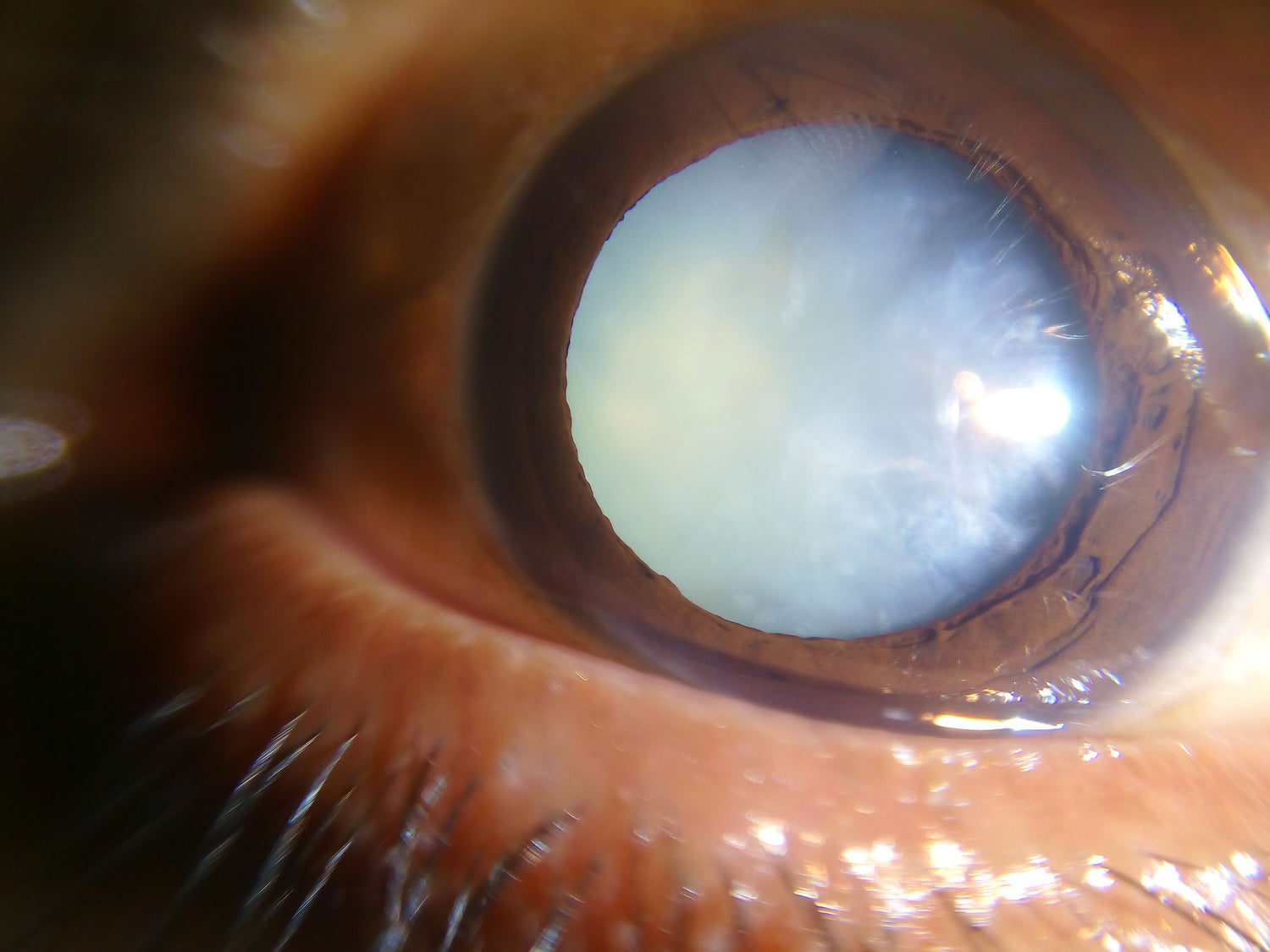A cataract of the eye is the opacification of the previously clear natural lens.

The lens works in concert with the front clear surface of the eye - the cornea - to focus light on the retina in the back of the eye. So although the cornea isn't called, "the lens," it acts as one of two lenses for the eye. Practically, the cornea is responsible for about 2/3 of the focus power, and the lens itself is responsible for about 1/3 of the focus power. You can think of the cornea and lens of the eye as the two "focusing elements" of the eye, just like in a camera.

When we are young, the natural lens of the eye is both clear and soft like gelatin. Its malleability allows young people to see both near and far, as the lens bulges and flattens, although some will require eyeglasses to correct their distance vision.
In youth, there are three common situations that might require eyeglasses for distance:
-
Myopia - AKA "nearsightedness - Your cornea and lens are working fine, but the point of focus of light is in front of the retina. And nothing you can do physically or by trying will move that focal point backward to the retina. Eyeglass and contact lenses for myopia are concave shaped, and slightly DIVERGE the beams of light so that they do not CONVERGE too quickly in front of the retina.
-
Hyperopia - AKA "far-sightedness" - The focal point lies slightly BEHIND the retina. If mild, a child or young adult can flex their focusing muscles and "push" the image forward. But if the hyperopia is very high, they require eyeglasses or contact lenses to do so.
- Astigmatism - Most commonly, this is when the clear cornea in the very front of the eye is shaped like an oval rather than part of a sphere. The image in the back of the eye then fails to focus as a tiny point, which is required for clear vision.
In elderly people, each of the same three problems with clear focus can occur, but they get one more problem:
- Presbyopia - The natural lens not only opacifies with age, it hardens. As that worsens beginning at age 40, the age that people begin to depend on reading glasses for close vision. The only exception is people with natural myopia ("nearsightedness") can read ONLY IF THEY REMOVE THEIR DISTANCE GLASSES.
In cataract surgery, the natural lens of the eye is broken into pieces and vacuumed out. But since the lens is responsible for 1/3 of focus and is a critical element in the eye's focusing system, it must be replaced. Otherwise, the light rays will fail to focus light to a tiny spot on the retina, and the image will be very blurred.
Artificial lens implants, made from clear silicone or acrylic, serve the purpose of replacing the natural lens. They are available in a wide range of strengths. They can correct the patient's prior hyperopia, myopia and astigmatism. The trick is knowing what strength lens to implant into the eye.
Choosing the correct lens implant strength is now routine. It wasn't always. But even so, small and large errors continue to be made despite the plethora of measurements that are taken to make this calculation. Even in the best of hands, it is common to miss the targeted eyeglass prescription by 0.5 diopters (Aiming 0.00 but the patient ends up with a prescription of -0.5 or +0.5 diopters), or to end up with some astigmatism ("oval eye shape") that results in a blurred image unless eyeglasses are used post-operatively. Even when using exotic instrumentation such as the Alcon ORA interferometer, which takes an optical measurement of the eye on the OR table after the cataract is removed, small errors can occur.
Premium Lens Implants
Medicare and most insurers include payment for monofocal lenses. These are simple convex-shaped lenses that are designed to provide correction at distance only, and only in patients who don't already have astigmatism. Their cost to the surgery center is approximately $75, and the cost is "bundled" into the total fee that the health insurer pays to the surgery center. Fifteen years ago, Medicare prohibited the use of anything beyond the basic monofocal lens, but a subsequent ruling permitted patients to pay the cost difference of premium lens implants, "out of pocket." Since premium lenses provide usage benefits, many patients are willing to pay the cost difference.
There are four types of premium lens implants.
1. Toric (Astigmatic) Lens Implants - These lenses are inserted into the eye at a precise axis 90 degrees away from the axis that creates the oval focusing of the cornea. They can also correct a patient's myopia and hyperopia. Patients with astigmatism experience a marked improvement in clarity without glasses after surgery. Typically, vision is corrected for distance. These lenses do not increase night glare. Typical fees range from $1500-2000 out of pocket, per eye.
2. Extended depth of focus (EDOF) Lens Implants - These lens implants offer slight improvement of near vision. Patients can be expected to better see their car's dashboard, their watch, the temperature dial on their stove, and the buttons on a telephone. These lenses have minimal effect on night glare. Typical fees range from $2000-$3500 per eye.
3. Multifocal Lens Implants - These lenses have multiple concentric circular rings, and work by a different focusing principle known as diffractive optics. When light hits each of the various rings, it forms peaks and valleys of light waves. Where peaks "collide," they create an image in the back of the eye. These lenses are designed to create a peak on the retina, as well as in front of the retina to help the patient with reading vision without requiring glasses. But there is a trade-off for this functionality of obtaining both distance and near vision without glasses. These lenses induce halos around lights at night and some night glare. In most patients, the effect is mild, and well worth the eyes' new ability to function without glasses. But for some patients, the effect can be moderate or severe, even when their eye is healthy and the surgery went perfectly. In rare cases, the lens has to be removed and replaced with a different lens that provides less functionality but also fewer side effects. Typical cost is $2500-$3500 per eye.
4. Light Adjustable Lens Implant - This lens acts like an extended depth of focus lens but it has an important advantage. Because it contains molecules in the lens which can be activated by UV light, thereby changing the shape of the lens AFTER the surgery has been completed, it has the ability to refine and approach perfection for the desired refractive focal point, even if there has been a small error in preoperative calculations.
By changing the shape of the lens after the surgery is complete, it also has the ability to correct some astigmatism (oval eye optics). A disadvantage is that it typically does not allow patients to read at as close a distance as do multifocal lens implants, but this lens does NOT increase night glare, an advantage. Its best use is for perfectionistic adults who want the clearest possible vision with the greatest predictability that will occur. Many eye doctors would choose this technology for themselves. Currently, this lens is being implanted in a small number of people by a small number of surgeons. But the frequency is expected to grow. Typical cost is $3500-$4500 per eye.













